15+ Monthly Management Report Examples to Download
Preparing different sheets of essential business documents can sometimes pose more clutter. In business, there are budget, project, and other business management reports that you should take good care of to align different aspects and objectives of the company. You have to prepare the reports to provide clarity and transparency to every member of the organization. Perhaps, securing a written report is a helpful material in communicating various factors, such as achievements, project summaries, and incidents. As you start creating your monthly management reports, we provide you a list of examples for your reference below.
15+ Monthly Management Report Examples
1. Monthly Management Report
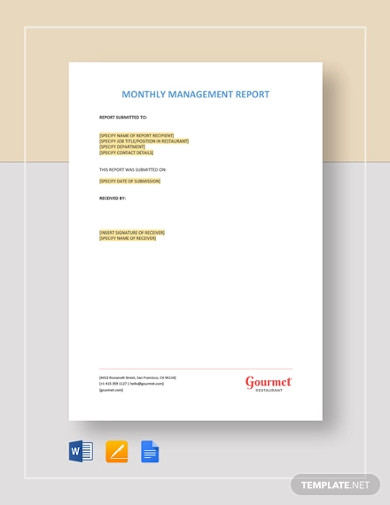
2. HR Monthly Management Report
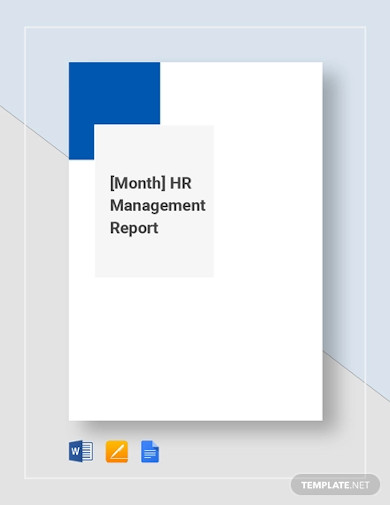
3. Company Monthly Management Report
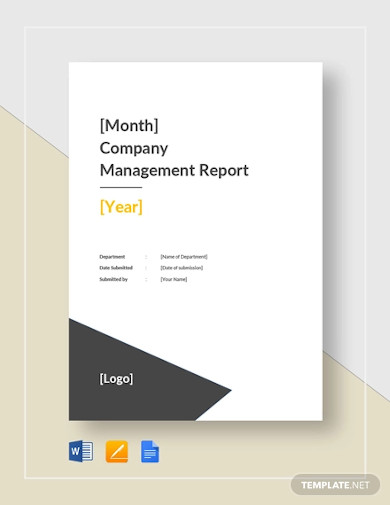
4. Monthly Product Management Report
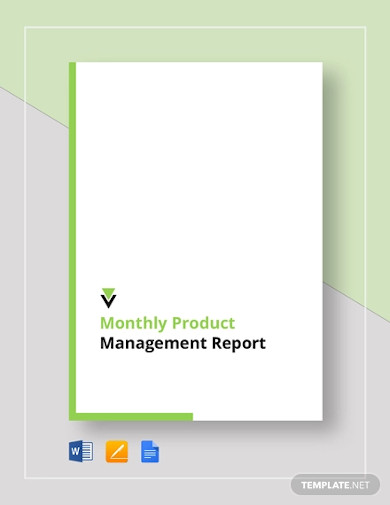
5. Monthly Quality Management Report
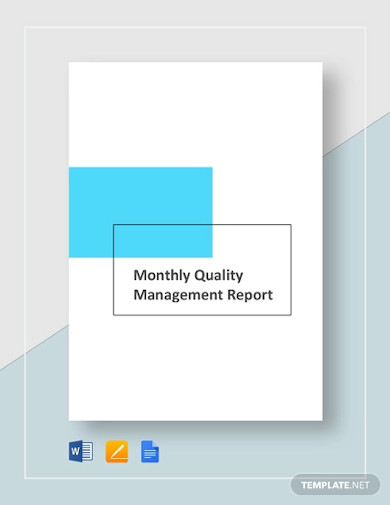
6. Sample Monthly Project Management Report
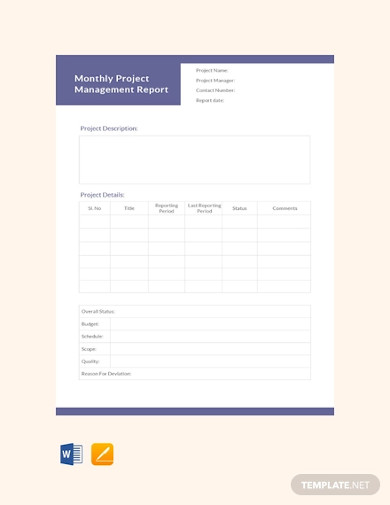
7. Monthly Risk Management Report
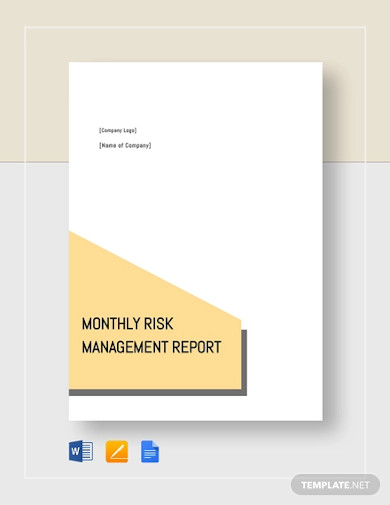
8. Monthly Project Management Report
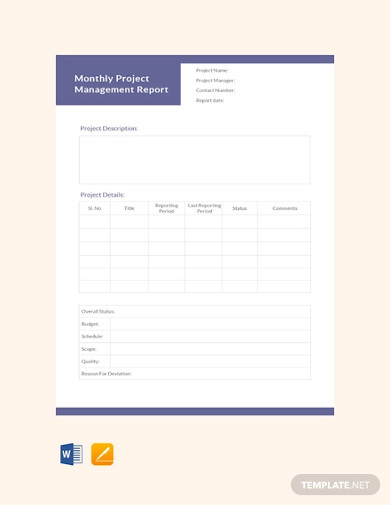
9. Simple Monthly Management Report
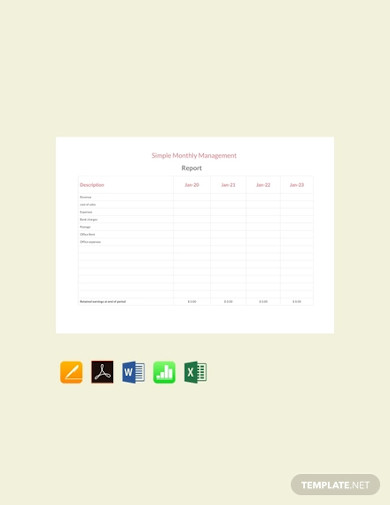
10. Monthly Budget Management Report
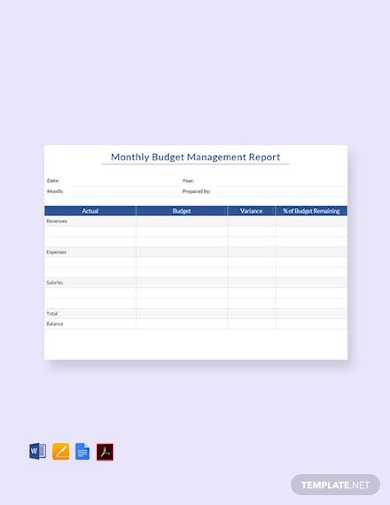
11. Property Management Monthly Report
12. Monthly Financial Management Report
13. Banking Monthly Asset Management Report
14. Waste Management Monthly Report
15. Monthly Management Report Example
16. Printable Monthly Management Report
What Is a Monthly Management Report?
Every organization needs proper management when it comes to the factors that help in running the business. Administrations follow various tips for business management. But to ensure that managers can track down business data, audit issues, and record expenses, a monthly report is needed. In the business industry, it is an important tool that guides managers to trace different sections of the business. This greatly affects the decision-making for the benefit of the company. But more than that, it also serves as an assessment of performance in a clearer way.
How a Management Report System Helps in Business Success
Why do companies need to prepare a management report? It’s simple, it’s because reports are a helpful method in understanding the massive scope of business flow. With technological advancements, reports have undergone various transformations. According to an article published by Gina Shaw in Medium, the importance of management report systems includes the enhancements of decision-making and improvement of response to issues within the work setting.
As you learn to prepare daily, weekly, or monthly reports, this helps in targeting an easy quality management evaluation. Since management report systems collect relevant information, easy identification of problems will be an essential factor in achieving business success.
How To Prepare a Monthly Management Report
Report writing is fun until you realize you are missing important points. But do not worry. This is why you are here. The list of steps below will help you in preparing your management report for your monthly evaluation. Let’s get started.
1. Establish a Brand and a Mission
Take into account that the first step towards developing a comprehensive business or technical report is determining your brand. With this, you have to identify the image your company is showcasing. Next is to create an outline of your mission. Now, remember that your mission statement must align well with your brand. Since this is written on the first page of your document, it must hook the users or readers. Make it more comprehensive and remain true to what your organization promotes.
2. Identify Your Objectives
What is a mission without objectives all along? Goals and objectives in the workplace are significant in preparing a good report. Are you making a monthly statistics report? Or a monthly income report, perhaps? Know what it is for and provide a valid reason why it is relevant in the current status of your business. Outline all your objectives that will help in achieving your goals. Now, discuss these with the administration. Make sure to prepare an executive summary that will show a brief explanation of the report.
3. Lay the Content
Now that you have listed smart goals, mission, and objectives, begin with the content. Financial reports or certain types of documents have different sections. You need to separate each item from another. To do this, be clear when writing the title headings. Detail all the resources involved in this monthly report. Define the tools, count the staff, and calculate the expense budget. Explain each expense or operation cost and elaborate on how it is used for. A monthly budget report will help you track expense limitations.
4. Incorporate Diagrams
At this point, complete your report by adding relevant information. For example, if you are launching a new product that caters up to a hundred guests you can visually showcase the number of people that attended using a diagram. It can be done through pie charts or bar graphs. Represent your data through images that compare and contrast different variables. As a result, you can create a comprehensive analysis report. Use visuals to make the formal analysis report more appealing and exciting for the administration to browse through.
5. Proofread It
Errors can cause severe problems. But this is avoidable. Don’t submit a company analysis report without reviewing it. As a standard rule, you have to proofread each section in the document. In case you are doubtful, read every page. Once everything is in place, all you have to do is send it to the management through email.
FAQs
What are the five types of a report?
Reports have various types. But the five most common ones are the short or long reports, proposal reports, periodic reports, technical reports, and analytical reports. Although there are many on the list, these are the most commonly used.
What are the main methods of reporting?
Reporting is made by following two primary methods. These are the written reports and visual or oral reports. These two functions the same but work for different purposes.
What are three examples of business reports?
Incident reports, annual reports, and budget reports are among the various types of business reports. Most companies use these types to track the progress of their organization.
Thrive to survive, they say. This saying applies in the business industry too. As you start to progress, it is always important to prepare essential details in a written or visual report. Come up with a progress report that will outline the performance, budget, problems, and achievements that your company can relate to. Take a look at the list of steps above. But first, collect the data and continue the process to run your business effectively.
15+ Monthly Management Report Examples to Download

Preparing different sheets of essential business documents can sometimes pose more clutter. In business, there are budget, project, and other business management reports that you should take good care of to align different aspects and objectives of the company. You have to prepare the reports to provide clarity and transparency to every member of the organization. Perhaps, securing a written report is a helpful material in communicating various factors, such as achievements, project summaries, and incidents. As you start creating your monthly management reports, we provide you a list of examples for your reference below.
15+ Monthly Management Report Examples
1. Monthly Management Report

Details
File Format
MS Word
Google Docs
Apple Pages
Size: A4 & US
2. HR Monthly Management Report

Details
File Format
MS Word
Google Docs
Apple Pages
Size: A4 & US
3. Company Monthly Management Report

Details
File Format
MS Word
Google Docs
Apple Pages
Size: A4 & US
4. Monthly Product Management Report

Details
File Format
MS Word
Google Docs
Apple Pages
Size: A4 & US
5. Monthly Quality Management Report

Details
File Format
MS Word
Google Docs
Apple Pages
Size: A4 & US
6. Sample Monthly Project Management Report

Details
File Format
MS Word
Apple Pages
Size: A4 & US
7. Monthly Risk Management Report

Details
File Format
MS Word
Google Docs
Apple Pages
Size: A4 & US
8. Monthly Project Management Report

Details
File Format
MS Word
Apple Pages
Size: A4 & US
9. Simple Monthly Management Report

Details
File Format
PDF
MS Word
Excel
Apple Pages
Apple Numbers
Size: A4 & US
10. Monthly Budget Management Report

Details
File Format
PDF
MS Word
Google Docs
Apple Pages
Size: A4 & US
11. Property Management Monthly Report
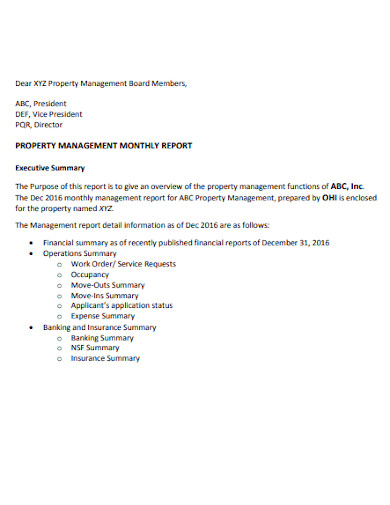
outsourcinghubindia.org
Details
File Format
PDF
Size: 702 KB
12. Monthly Financial Management Report
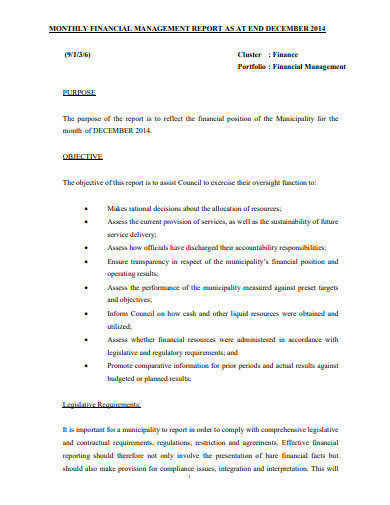
sedibeng.gov
Details
File Format
PDF
Size: 81 KB
13. Banking Monthly Asset Management Report
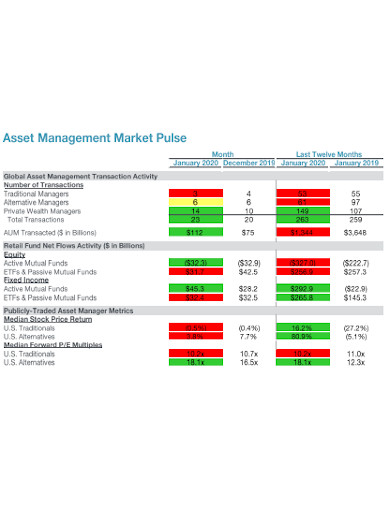
pipersandler.edu
Details
File Format
PDF
Size: 2 MB
14. Waste Management Monthly Report
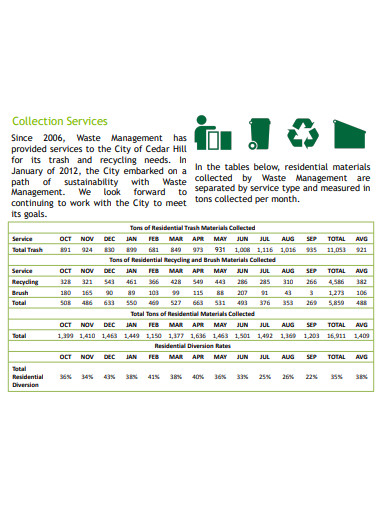
cedarhilltx.org
Details
File Format
PDF
Size: 650 KB
15. Monthly Management Report Example

offaly.gov
Details
File Format
PDF
Size: 1 MB
16. Printable Monthly Management Report
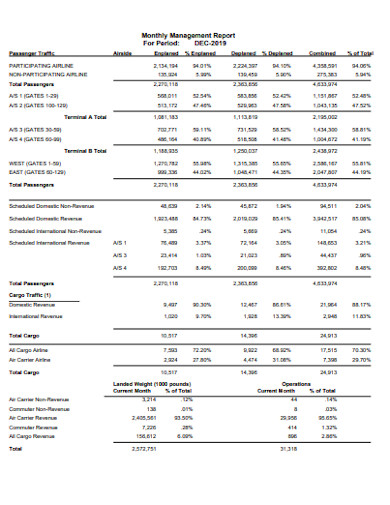
orlandoairports.net
Details
File Format
PDF
Size: 20 KB
What Is a Monthly Management Report?
Every organization needs proper management when it comes to the factors that help in running the business. Administrations follow various tips for business management. But to ensure that managers can track down business data, audit issues, and record expenses, a monthly report is needed. In the business industry, it is an important tool that guides managers to trace different sections of the business. This greatly affects the decision-making for the benefit of the company. But more than that, it also serves as an assessment of performance in a clearer way.
How a Management Report System Helps in Business Success
Why do companies need to prepare a management report? It’s simple, it’s because reports are a helpful method in understanding the massive scope of business flow. With technological advancements, reports have undergone various transformations. According to an article published by Gina Shaw in Medium, the importance of management report systems includes the enhancements of decision-making and improvement of response to issues within the work setting.
As you learn to prepare daily, weekly, or monthly reports, this helps in targeting an easy quality management evaluation. Since management report systems collect relevant information, easy identification of problems will be an essential factor in achieving business success.
How To Prepare a Monthly Management Report
Report writing is fun until you realize you are missing important points. But do not worry. This is why you are here. The list of steps below will help you in preparing your management report for your monthly evaluation. Let’s get started.
1. Establish a Brand and a Mission
Take into account that the first step towards developing a comprehensive business or technical report is determining your brand. With this, you have to identify the image your company is showcasing. Next is to create an outline of your mission. Now, remember that your mission statement must align well with your brand. Since this is written on the first page of your document, it must hook the users or readers. Make it more comprehensive and remain true to what your organization promotes.
2. Identify Your Objectives
What is a mission without objectives all along? Goals and objectives in the workplace are significant in preparing a good report. Are you making a monthly statistics report? Or a monthly income report, perhaps? Know what it is for and provide a valid reason why it is relevant in the current status of your business. Outline all your objectives that will help in achieving your goals. Now, discuss these with the administration. Make sure to prepare an executive summary that will show a brief explanation of the report.
3. Lay the Content
Now that you have listed smart goals, mission, and objectives, begin with the content. Financial reports or certain types of documents have different sections. You need to separate each item from another. To do this, be clear when writing the title headings. Detail all the resources involved in this monthly report. Define the tools, count the staff, and calculate the expense budget. Explain each expense or operation cost and elaborate on how it is used for. A monthly budget report will help you track expense limitations.
4. Incorporate Diagrams
At this point, complete your report by adding relevant information. For example, if you are launching a new product that caters up to a hundred guests you can visually showcase the number of people that attended using a diagram. It can be done through pie charts or bar graphs. Represent your data through images that compare and contrast different variables. As a result, you can create a comprehensive analysis report. Use visuals to make the formal analysis report more appealing and exciting for the administration to browse through.
5. Proofread It
Errors can cause severe problems. But this is avoidable. Don’t submit a company analysis report without reviewing it. As a standard rule, you have to proofread each section in the document. In case you are doubtful, read every page. Once everything is in place, all you have to do is send it to the management through email.
FAQs
What are the five types of a report?
Reports have various types. But the five most common ones are the short or long reports, proposal reports, periodic reports, technical reports, and analytical reports. Although there are many on the list, these are the most commonly used.
What are the main methods of reporting?
Reporting is made by following two primary methods. These are the written reports and visual or oral reports. These two functions the same but work for different purposes.
What are three examples of business reports?
Incident reports, annual reports, and budget reports are among the various types of business reports. Most companies use these types to track the progress of their organization.
Thrive to survive, they say. This saying applies in the business industry too. As you start to progress, it is always important to prepare essential details in a written or visual report. Come up with a progress report that will outline the performance, budget, problems, and achievements that your company can relate to. Take a look at the list of steps above. But first, collect the data and continue the process to run your business effectively.

